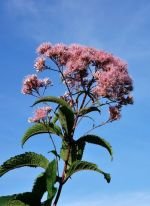Prostrate Knotweed
Prostrate Knotweed/Knotweed/Knot Weed (Polygonum aviculare)
|
This weed's origin is uncertain, Regardless of origin it is now all |
 |
It is from the Buckwheat and Dock Family (Polygonaceae) with a genus of about 200 species.
Knot weed is a broadleaf summer annual. It grows prostrate, laying flat or level to the ground and forms dense mats. Although it can tolerate many soil conditions, it thrives in poor, compacted soils, especially where high foot traffic occurs. Because of this, other names include Knotgrass, because it gets densely knotted up. Doorweed and Waygrass which refers weed is found where people walk be it through doors or on sidewalks.
Pigweed is another name given to prostrate knotweed. It does not refer to the actual weed itself, rather it is a generic term. Pig Weed can translate to Pig Fodder, or food for livestock. This can be many different weeds.
Knotweed is also one of the earliest germinating weeds in spring. It grows where water is found, such as wetlands, wet meadows or slightly moist soils. Because of these two combinations, there is likely to be little competition from other weeds.
|
Smooth, wiry stems grow anywhere from 2 inches to 7 feet. Lengths average about 48 inches, or 4 feet. Blue-green colored elliptical shaped leaves alternate on stem and grow anywhere up to 1 inch long and 1/3 inch wide. Leaves and leaf margins are smooth. Small flower clusters of about 2-6 are pink to white in color. Actually, they are cymes. |
 |
A cyme is one flower developing off of a primary axis, continued by secondary flowers, then tertiary flowers off of the secondary axes. Depending on location in the country flowers first appear anywhere from March (Southwest), May (Southeast) to June (Great Plains/Midwest) until October-November.
Prostrate knotweed thrives in full sun but will also grow in partial sun and even shade. The key is the moist soil, regardless if it is acidic or alkaline. It's overwhelming preference, however, would be well packed soils that are highly acidic.
The weed reproduces by seed and because it is low to the ground cross-pollination happens in many ways. Not only is this a pig weed, it attracts all kinds of wildlife, including birds to crawling insects. Once germinated a small taproot grows and spreads. This weed is often confused with crab grass. Both germinate in early spring starting from one small erect stem with tiny leaves.
Because it forms dense patches, depending on it's location, knot weed can assist in preventing soil erosion. One is more likely to want to eradicate it. If so, pulling this weed requires persistence. Because of the constant pollination and the root web beneath the soil surface elimination takes time. A better bet would be to do a soil pH test. Soil test kits are easily purchased and will help in understanding how to better the soil quality where weed grows (see 'Related Articles' below).
Both a post emergent and preemergent herbicide can be effective at controlling prostrate knotweed. Depending on the area size where the weed is growing boiling water can work effectively as a preemergent. If it is a larger area try burning weeds.
FYI:
- The flowers of this weed are hermaphrodite, or self-fertile. Having both male and female organs, the plant can reproduce on it's own. Not all plants have hermaphroditic flowers.
- Cousins of Prostrate Knotweed from the same familiy include:
Erect Knotweed (Polygonum erectum)
Bushy Knotweed (Polygonum ramosissimum)
Related Articles:
Back from Prostrate Knotweed to Weed Identification
Back from Prostrate Knotweed to Easy Butterfly Garden.com
 Copyright © 2010-2015 Easy-Butterfly-Garden.com
Copyright © 2010-2015 Easy-Butterfly-Garden.com
Privacy Policy Disclaimer
 Print Print
|

Join Easy Butterfly Garden on Facebook
Recent Articles
-
Daylillies
Sep 27, 15 12:13 PM
Daylillies attract all kinds of butterflies and are a very durable plant, even in winter. Cultivers come in different forms and colors. As beautiful as they are, there is one drawback...
-
Joe Pye Weed
Sep 13, 15 02:11 PM
Joe pye weed looks great in a more casual garden setting. It's not considered invasive but between the many seeds and the fast growing rhizome system, it needs to be controlled.
-
Daisy Flower
Aug 30, 15 03:37 PM
The up-side to the daisy flower is that it is up when the sun is feeding pollinators. The down side is that one particualar species is invasive.
-
This Gardening and Butterfly Websites Sitemap
Aug 16, 15 11:34 PM
This gardening and butterfly websites sitemap for easier navigation.
-
Calliopsis
Aug 16, 15 11:28 PM
Calliopsis is a name shared by other flowering plants in the Asteraceae familiy. These include Tickseed and the Coreopsis perennial.





New! Comments
Have your say about what you just read! Leave me a comment in the box below.